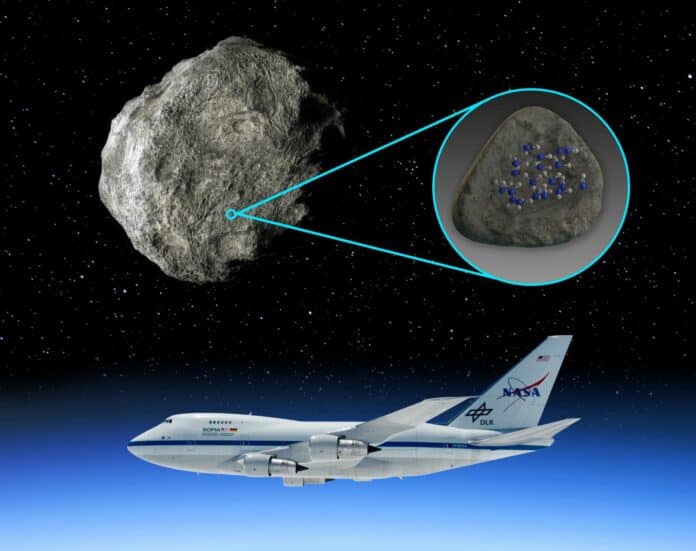Asteroids have different compositions depending on where they formed. As the solar system evolved, some asteroids have undergone aqueous alteration, forming phyllosilicates, sulfates, oxides, carbonates, and hydroxides. These features can sometimes be identified through visible and near-infrared spectroscopy.
The distribution of water on asteroids is exciting because it can shed light on how water was delivered to Earth.
Using data from the retired Stratospheric Observatory for Infrared Astronomy (SOFIA) — a joint project of NASA and the German Space Agency at DLR — Southwest Research Institute scientists have discovered, for the first time, water molecules on the surface of an asteroid. Scientists looked at four silicate-rich asteroids using the FORCAST instrument to isolate the mid-infrared spectral signatures of molecular water on two of them.
SwRI’s Dr. Anicia Arredondo, lead author of a Planetary Science Journal paper about the discovery, said, “We detected a feature that is unambiguously attributed to molecular water on the asteroids Iris and Massalia. We based our research on the team’s success that found molecular water on the sunlit surface of the Moon. We thought we could use SOFIA to find this spectral signature on other bodies.”
SOFIA, NASA’s airborne observatory, identified water molecules in a large crater located in the southern hemisphere of the Moon. Previous studies had detected hydrogen on both the Moon and asteroids but couldn’t distinguish between water and its close chemical relative, hydroxyl. Scientists found that the amount of water detected is roughly equivalent to a 12-ounce bottle spread across a cubic meter of lunar soil, where it’s chemically bound in minerals.
The team also investigated two fainter asteroids, Parthenope and Melpomene, but the data needed to be quieter to draw clear conclusions. Although the FORCAST instrument used in this study lacked the sensitivity to detect water spectral features in these asteroids, the team plans to utilize NASA’s James Webb Space Telescope for further investigations. With its precise optics and superior signal-to-noise ratio, the James Webb Space Telescope will allow scientists to explore more targets and potentially uncover more about the presence of water in asteroids.
Arredondo said, “We have conducted initial measurements for another two asteroids with Webb during cycle two. We have another proposal in for the next cycle to look at another 30 targets. These studies will increase our understanding of the distribution of water in the solar system.”
Journal Reference:
- Anicia Arredondo, Margaret M. McAdam et al. Detection of Molecular H2O on Nominally Anhydrous Asteroids. The Planetary Science Journal. DOI 10.3847/PSJ/ad18b8
